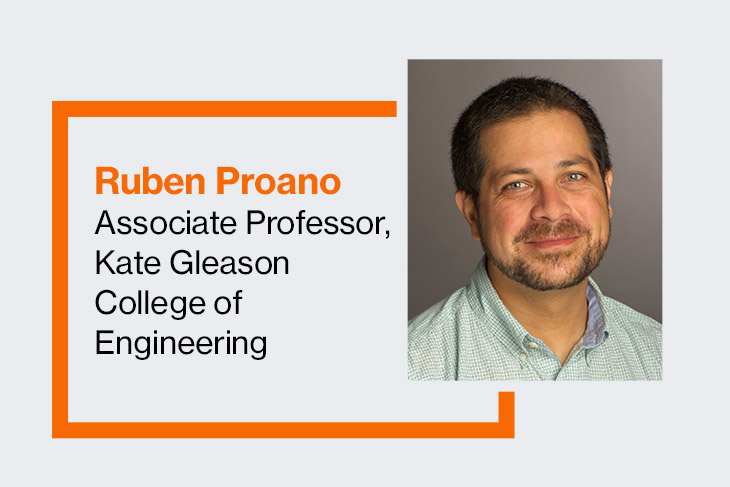Faculty-researcher sees COVID-19 unfold from global perspective while on sabbatical at UNICEF
Engineering faculty member Ruben Proano reflects on international approaches to health care
While the pandemic touched RIT locally, Ruben Proano, associate professor of industrial engineering in RIT’s Kate Gleason College of Engineering, saw it from a global perspective, as part of a year-long sabbatical at UNICEF in Copenhagen, Denmark. He has since returned to Rochester and is teaching this fall semester. His work in Denmark extended ongoing research on making the vaccine market more affordable and profitable, and studying how to set up a global safety stock for Ebola vaccines. As COVID-19 unfolded, he experienced the impact of the pandemic on the UNICEF Center responsible for global vaccine distribution. In an interview, he shared information about the different perspectives of the pandemic from the viewpoint of an international health care advocacy organization and how the experience will enrich his teaching and scholarship.
What was your role with UNICEF and how did it relate to your previous work?
By the time I joined the UNICEF Vaccine Center, the Ebola outbreak in the Democratic Republic of Congo was not contained yet; I was asked to model and study the impact of a centralized Ebola vaccine safety stock to mitigate future Ebola outbreaks in 25 African countries. There are several Ebola strains and outbreak characteristics can change, depending on many factors including access and characteristics of local healthcare systems, population density, migration patterns, and social practices such as burials. I designed and programmed a system that integrates a network of compartmentalized epidemiological models with a migration flow model, and a continued review inventory system.
Through the analysis of 10 experimental factors, we simulated more than 1,000 Ebola outbreaks. The study offered insights on how to make the safety stock more effective and the features that UNICEF/WHO can control. Because of the limited supply of Ebola vaccines, immunization follows a ring vaccination strategy, where only those in contact with an infectious individual and their contacts are vaccinated. A key finding of our work with implications to our COVID times, is vaccines on their own are not sufficient to contain intense outbreaks. In fact, the effectiveness of having a centralized Ebola safety stock is maximized if contact tracing is effective.
When COVID-19 was first revealed, how did your work change?
As the COVID pandemic started, global vaccine distribution was interrupted or suspended. The UNICEF Vaccine Center began a prioritization process to send urgent vaccine orders through any available transportation channel. UNICEF coordinates vaccine distribution to more than 70 countries and has to interact with suppliers, local governments, and health agencies. I was asked to propose modeling alternatives to facilitate the prioritization process. My colleagues at UNICEF took into consideration multiple plans to ensure that as many critical vaccines were available where needed. UNICEF worked to resolve incredibly complex logistics problems. While the world saw the COVID devastation in China, New York, Italy, and Spain, the Vaccine Center dealt with the shock waves that put children at risk of diseases more lethal than COVID. Every day, the conditions in the field changed. By May, an international effort resulted in a system that helped visualize the vaccine levels available across the supply chain of the poorest countries around the globe. UNICEF used this information to generate consensus and consolidate orders, change delivery routes, and help countries prepare for shortages. By June, orders were already catching up with pre-pandemic levels.
What aspects of the organization made an impression on you?
At the UNICEF Vaccine Center people are driven completely by a sense of purpose; everyone I met was committed to help children that they did not know. Additionally, UNICEF, its Supply Division, and the Vaccine Center were led by women. The discussions about well-being, work-life balance, and work purpose were very different from conversations I have experienced at RIT; they were richer, and in many ways, more sincere, and open. I feel that universities often lose their focus. At times it seems that most of our work aims to seek recognition. We forget that recognition comes from the incredible service we can provide. At the UNICEF Supply Division, it seemed that no one cared for recognition, or PR. Everyone was committed to saving the lives of children. Being part of such a group was incredibly motivating. That is something I will carry in my heart.
How will you incorporate this work into your classes and research?
I learned a lot from talking to my colleagues and their global health partners. I have curated an agenda of research problems that I hope could attract students to collaborate. COVID disruption on the vaccine supply chain will be evident after the pandemic passes; the whole vaccine supply chain will be disrupted. I am interested in problems that can help readjust the vaccine supply chain systems after COVID.
As part of my sabbatical, I am committed to putting together a graduate course on global health and humanitarian logistics. In this course, we will study the effects of COVID on healthcare logistics—supply chain disruptions, vaccine issues, and global logistics. I plan to offer a course through a series of decision-making problems that can be addressed from a mathematical modeling perspective. In industrial engineering, we design how people make decisions, and I believe that the COVID situation has proved the need to study decision problems within global social contexts. I have colleagues at UNICEF who are willing to share their experiences through webinars. My goal is to attract students from the College of Health Sciences and Technology, Kate Gleason College of Engineering, and other colleagues in a course that can show the role of mathematics and decision sciences in public health. My goal is to offer students the opportunity to realize the benefits of a systemic perspective about these problems, and the difficulties that prevent having coordinated efforts.







